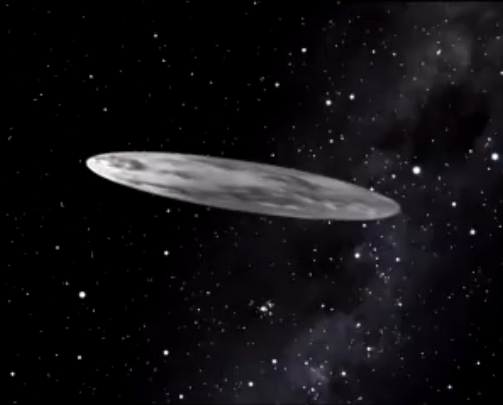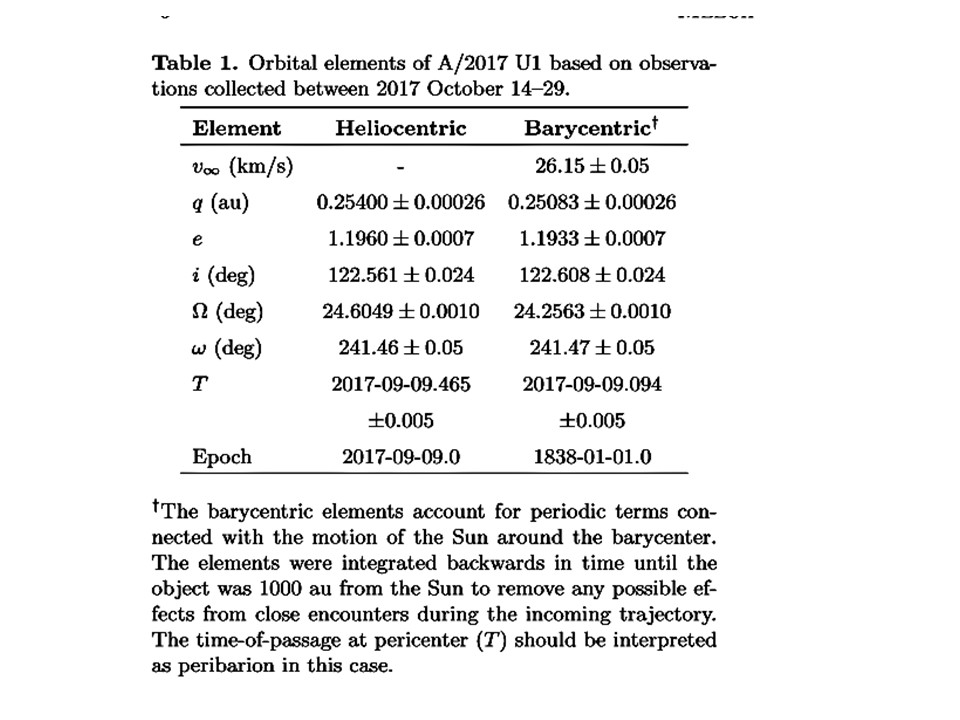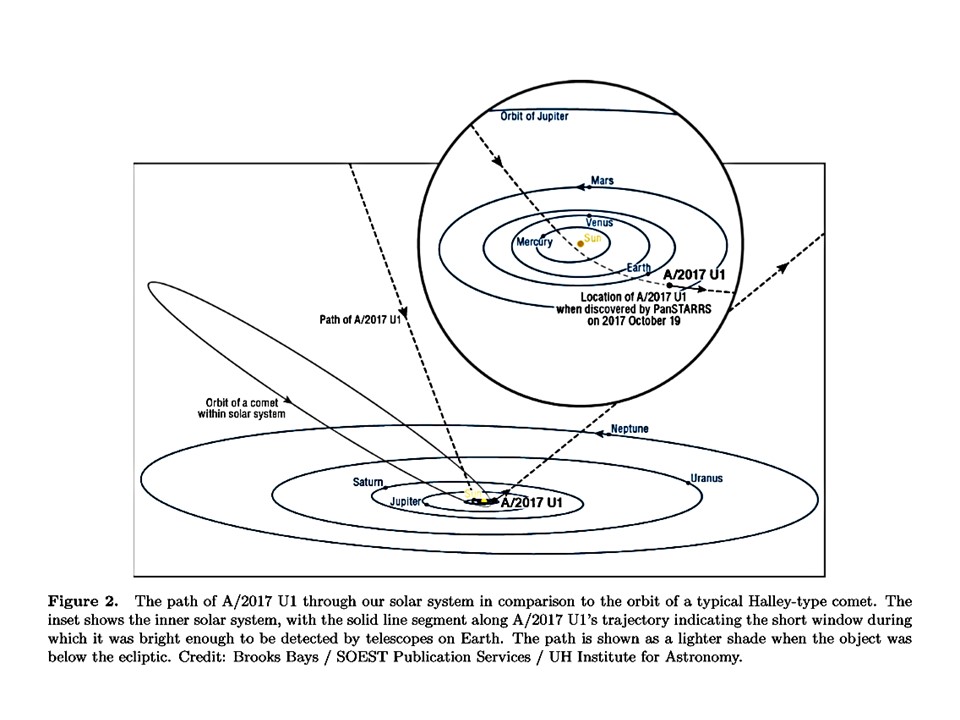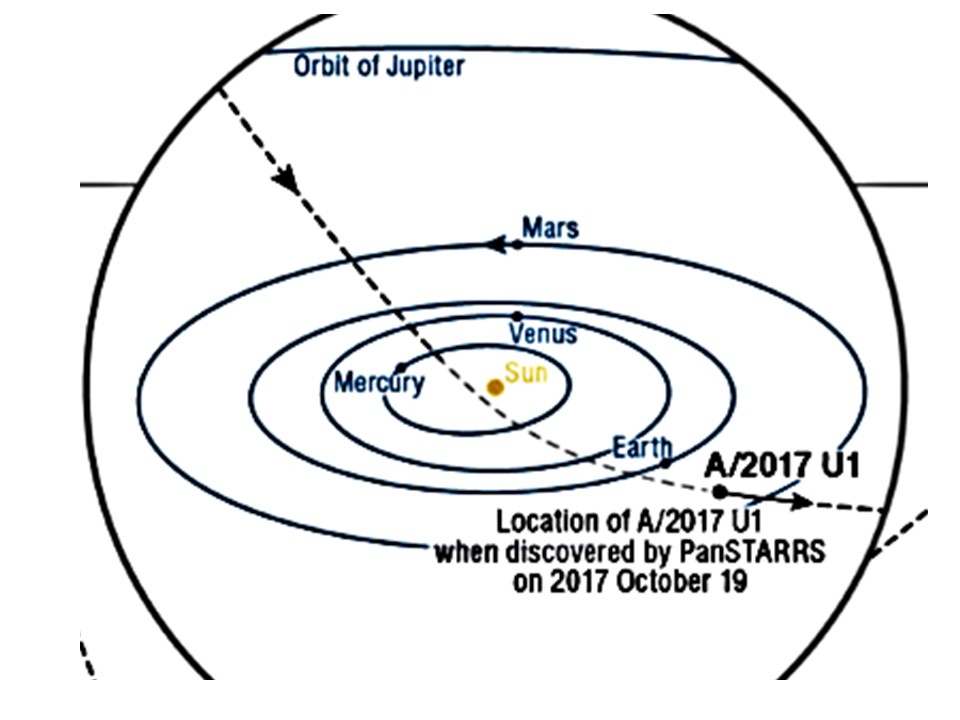It looks like you're using an Ad Blocker.
Please white-list or disable AboveTopSecret.com in your ad-blocking tool.
Thank you.
Some features of ATS will be disabled while you continue to use an ad-blocker.
share:
The mass, a quarter mile (400 meters) in diameter, quickly stood out for scientists because of its extreme orbit, coming from the direction of the constellation Lyra
www.telegraph.co.uk...
Lyra !

Curious how the mystery object came closest to Earth before returning wence it came , pretty sure it's not a probe from Alpha Centauri , unless it is.
Perhaps it's a scout for the inbound Mystery Comet heading our way.
edit on 28-10-2017 by gortex because: (no reason given)
originally posted by: 0zzymand0s
a reply to: intrptr
The angle of its dangle. I blame math and space cloverleaf freeway off-ramps, personally.
Haha, nice reference to "Hitch Hikers Guide".
originally posted by: gortex
The mass, a quarter mile (400 meters) in diameter, quickly stood out for scientists because of its extreme orbit, coming from the direction of the constellation Lyra
www.telegraph.co.uk...
Lyra !
Just Prot making his interstellar rounds.

a reply to: MuonToGluon
How about this alternative: set instruments embedded within a large, high tensile strength net, and set the net in the path of the high speed object. Then *BAM* object hits the net, which wraps around it and adheres to the object, carrying the sensor package out of the solar system with it.
The problems I see: need a really tough, resilient net material, and really resilient to impact / stress sensor package.
But why could that not work, instead of trying to get up to speed to intercept an object like this?
How about this alternative: set instruments embedded within a large, high tensile strength net, and set the net in the path of the high speed object. Then *BAM* object hits the net, which wraps around it and adheres to the object, carrying the sensor package out of the solar system with it.
The problems I see: need a really tough, resilient net material, and really resilient to impact / stress sensor package.
But why could that not work, instead of trying to get up to speed to intercept an object like this?
Intriguing that the SETI Institute has shown considerable interest in this hyperbolic object, provisionally classed as an asteroid. The website of the
Allen Telescope Array had reported their intention to observe it in the radio range 1 to 3 GigaHertz on October 30th. Now, it reports that they will
observe it again, tonight.
Asteroids are not known for radio emissions. It appears that they are considering the possibility that the mysterious object is something else, altogether. Please find a link to the website, below:
www.setiquest.info...
Asteroids are not known for radio emissions. It appears that they are considering the possibility that the mysterious object is something else, altogether. Please find a link to the website, below:
www.setiquest.info...
This little visitor has caused the International Astronomical Union to do something significant: they introduced a new series of small-body
designations for interstellar objects. www.minorplanetcenter.net...
Visiting interstellar objects will be named using the letter I (capital "i"), for "Interstellar".
Visiting interstellar objects will be named using the letter I (capital "i"), for "Interstellar".
a reply to: Somekindofwizard
This is a nostalgic topic for me. When I was an undergraduate in my physics department I wrote a paper (just for school, not published) on cometary dynamics. I did a simulation of orbital motion and slingshots, learning how to integrate ODE's numerically. I simulated a distribution of incoming comets from the Oort cloud, which come in nearly exactly parabolically and looked at how their course was altered by planets (I think only Jupiter & Saturn really mattered). There was a certain flux of them which were ejected in hyperbolic orbits, i.e. escape velocity outside the solar system.
The problem was "well, where are the ejected comets from the other star systems around us." At that time, and until very recently, no hyperbolic incoming comets have ever been observed. I made some crude estimates of star and comet density and how many were ejected from Earth and came to the conclusion that an interstellar comet should have been observed already but wasn't and presented it as an unsolved mystery.
And now we have one.
edit: well crap. It's an asteroid, not a comet, but anyways, we are probably seeing the exhaust of another planetary system's slingshot.
This is a nostalgic topic for me. When I was an undergraduate in my physics department I wrote a paper (just for school, not published) on cometary dynamics. I did a simulation of orbital motion and slingshots, learning how to integrate ODE's numerically. I simulated a distribution of incoming comets from the Oort cloud, which come in nearly exactly parabolically and looked at how their course was altered by planets (I think only Jupiter & Saturn really mattered). There was a certain flux of them which were ejected in hyperbolic orbits, i.e. escape velocity outside the solar system.
The problem was "well, where are the ejected comets from the other star systems around us." At that time, and until very recently, no hyperbolic incoming comets have ever been observed. I made some crude estimates of star and comet density and how many were ejected from Earth and came to the conclusion that an interstellar comet should have been observed already but wasn't and presented it as an unsolved mystery.
And now we have one.
edit: well crap. It's an asteroid, not a comet, but anyways, we are probably seeing the exhaust of another planetary system's slingshot.
edit
on 17-11-2017 by mbkennel because: (no reason given)
originally posted by: Alien Abduct
a reply to: intrptr
My guess is it might have something to do with speed. Other than that I have no idea how they could tell. I would love for them to get a sample of that thing if it is in fact interstellar though!
Yes, it's very clear from good old Newtonian dynamics that the incoming object has a significant velocity "originally" when at the edge of the solar system. Elliptical = lower energy, the orbits close to us, known periodic comets. Parabolic (medium energy) = on the edge, must have started out from extremely far away (compared to our regular comets, from Oort cloud). Hyperbolic = highest initial kinetic energy, shot into our solar system with a noticable velocity at the edge of the Oort cloud.
The Oort cloud is composed of zillions of quiet comets, but the cloud moves with center of mass of the Sun, so it's almost as if the comets just 'fall' in from very far away. But an object on a clear hyperbolic orbit means it was spewn out from another star system, probably from a gravitational nudge from the other system's astroid belt or oort cloud, and slingshot through a massive planet (we've discovered many big gas giants).
edit on 17-11-2017 by mbkennel because: (no reason given)
So, what have we learned about this "guest" in meanwhile?
The object, known to astronomers as 1I/2017 U1, measures 180 meters by 30 meters. In shape, the object resembles a fat cigar, half a city block long, and rotates on an axis about once every eight hours. It also has a reddish tinge and a low albedo. news.wisc.edu...
Abe S. Shinnosuke posted an artistic rendering and rotating animation of 1I/2017 U1 (`Oumuamua) on Twitter
twitter.com...

That's one funky object, I've never seen an asteroid like that!
The object, known to astronomers as 1I/2017 U1, measures 180 meters by 30 meters. In shape, the object resembles a fat cigar, half a city block long, and rotates on an axis about once every eight hours. It also has a reddish tinge and a low albedo. news.wisc.edu...
Abe S. Shinnosuke posted an artistic rendering and rotating animation of 1I/2017 U1 (`Oumuamua) on Twitter
twitter.com...

That's one funky object, I've never seen an asteroid like that!
edit on 19-11-2017 by wildespace because: (no reason
given)
edit on 19-11-2017 by wildespace because: (no reason given)
With a 6 to 1 length to width ratio, the object is twice as long and thin as any asteroid belonging to our solar system. It seems an strange
coincidence that the only known visitor to our system should be such an oddly shaped object One wonders how it managed to assume such an extreme
form.
The absence of similarly shaped objects, native to our system, suggests that an asteroid of similar form could spin itself to pieces, or be knocked apart by an impact with other asteroids. Why this didn't happen to the hyperbolic visitor, now given the name ' Oumuamua' ?
The absence of similarly shaped objects, native to our system, suggests that an asteroid of similar form could spin itself to pieces, or be knocked apart by an impact with other asteroids. Why this didn't happen to the hyperbolic visitor, now given the name ' Oumuamua' ?
The article, linked below, has some new and interesting details about our hyperbolic visitor. The 'fat cigar' has become a quite thin one, it seems.
The light variations from the object, as it rotates, now imply a length to width ratio of at least 10 to 1. Unless the two ends align directly with
Earth, at minimum brightness, which would be quite a coincidence, the elongation would be even greater, we're told.
This doesn't seem to be a double asteroid, 'or contact binary', with two bodies touching at the narrow ends. The astronomers say it's spinning too fast for this to be a stable configuration. Some even less probable explanations for this object have been proposed.
www.bbc.com...
This doesn't seem to be a double asteroid, 'or contact binary', with two bodies touching at the narrow ends. The astronomers say it's spinning too fast for this to be a stable configuration. Some even less probable explanations for this object have been proposed.
www.bbc.com...
edit on 20-11-2017 by Ross 54 because: added information
edit
on 20-11-2017 by Ross 54 because: inserted capital letter, where indicated
edit on 20-11-2017 by Ross 54 because: added
information
a reply to: Ross 54
It is possible that the proportions estimates have been wrong. Light-curve method isn't infallible. I certainly cannot envision any natural process that would result in such an object.
Astronomers don't say it, but it's on everyone's minds - this may be an artificial metallic object (derelict spaceship, a capsule with some message, etc.)
It is possible that the proportions estimates have been wrong. Light-curve method isn't infallible. I certainly cannot envision any natural process that would result in such an object.
Astronomers don't say it, but it's on everyone's minds - this may be an artificial metallic object (derelict spaceship, a capsule with some message, etc.)
Interesting interview where asteroid hunter says they had guesstimated that there may be as many as 10,000 objects of this size CURRENTLY passing
through the Solar System [within 30AU of the sun, Neptune's orbit]. An average of 1 of them would be within 1 AU of the Sun and be detectable. At
expected speeds, they take up to ten years to pass through this volume.
www.youtube.com...
www.youtube.com...
The idea now seems to be that the object is quite dense. It would presumably have to be, to keep it from flying apart as it spins, given its long,
thin shape. The spectra of this object had suggested that it was similar to class D and P asteroids in our solar system. These have a quite low
density, only about 1.4 times that of water.
The trajectory of the object is interesting as it was a good angle to get next to us.
It will be interesting to see what the scans of this object reveal.
Am disappointed to see the mainstream media crack the meaning of its name 'Oumuamua' (a Hawaiian term meaning ‘a messenger from afar arriving first’) before the ATS community!
It will be interesting to see what the scans of this object reveal.
Why eminent scientists (including Stephen Hawking) say this quarter of a mile long cigar-shaped object hurtling through space at 196,000mph could be an alien spaceship: JOHN NAISH explains
Scientists led by Stephen Hawking are today using high-tech scanners to discover if a huge, cigar-shaped space object currently hurtling through our solar system was sent by an alien civilisation.
The object in question, christened ‘Oumuamua’, is about a quarter of a mile long, 260ft wide and currently travelling at 196,000mph. And while it could just be an asteroid, barmy as it may seem, researchers are taking seriously the possibility that it could instead be a spaceship.
The team of scientists, called Breakthrough Listen, will use the world’s largest directable radio telescope, at Green Bank in West Virginia, to follow it for ten hours.
They are listening for electromagnetic signals, no stronger than those emitted by a mobile phone, that cannot be produced by natural celestial bodies. If they find them, it would be proof that extraterrestrial forces really could be at play.
For the moment, they are trying to contain their excitement. But the name they have given this bizarre object betrays their optimism. Oumuamua is a Hawaiian term meaning ‘a messenger from afar arriving first’. (The far less sexy official name is A/207 U).
Most intriguingly, it is the wrong shape for an asteroid — they are typically round.
Hawking and his colleagues at Breakthrough Listen report: ‘Researchers working on long-distance space transportation have previously suggested that a cigar or needle shape is the most likely architecture for an interstellar spacecraft, since this would minimise friction and damage from interstellar gas and dust.’
Another oddity is that Oumuamua is flying very ‘cleanly’, without emitting the usual cloud of space dust that astronomers observe around asteroids.
Experts say this suggests it is made of something dense: probably rock, but possibly metal.
It was first detected on October 19 by a long-running research programme called Pan-STARRS, which uses powerful telescopes to photograph and monitor the night sky at the University of Hawaii. Its amazing speed has led some experts to conclude it is the first such object to have come towards us from outside our solar system. Analysts also say its faintly red colour indicates it has been subjected to interstellar cosmic radiation which is harsher than we experience in our solar system.
The fact that it doesn’t seem to have engines or show signs of propulsion may wreck the interplanetary-spacecraft theory. But Professor Avi Loeb, an astrophysicist from Harvard University, suggests it might just be coasting.
‘Perhaps the aliens have a mothership that travels fast and releases baby spacecraft that freely fall into planetary systems on a reconnaissance mission,’ Professor Loeb posited to the journal Scientific American.
‘In such a case, we might be able to intercept a communication signal between the different spacecraft.’ While he acknowledges that the chances of detecting alien activity are ‘very small’, Prof Loeb adds that it’s ‘prudent’ to check. After all, it could even turn out to be some sort of intergalactic Marie Celeste, the infamous ghost ship found drifting with no crew.
‘Even if we find an artefact that was left over — some space device or junk from an alien civilisation — and there are no signs of life on it, that would be the greatest thrill I can imagine having in my lifetime,’ he says. ‘It’s really one of the fundamental questions in science, perhaps the most fundamental: are we alone?’ Today, we may finally find out, even if it is a bit late.
When Oumuamua was first spotted, it was already heading away from Earth, having passed within 15 million miles of us on October 15. (That’s about 85 times the distance from Earth to the moon, which may sound an awfully long way, but considering the speed it travels, it’s really a squeak away.)
At that point, no alien passenger seems to have waved from the window. Perhaps they scanned Earth for signs of intelligent life and chose to keep whizzing along.
Nevertheless, we can still get a good enough look at Oumuamua’s rear end to detect any extraterrestrial technology on board, says Andrew Siemion, the research centre director at the Search for ExtraTerrestrial Intelligence (Seti) in California, which works with the scientists at Breakthrough Listen. The Green Bank telescope’s ten-hour scan will check for any transmissions across the full spectrum of electromagnetic wavelengths, Dr Siemion says.
‘It’s like a radio station you tune into with your car stereo,’ he explains. ‘Nature doesn’t broadcast on a very specific frequency — it smears it out. Technology behaves differently. It can compress electromagnetic energy. So we look for those specific signs and for repeating patterns which nature doesn’t tend to do. We look for structure.’
Presumably they are also looking for Nobel Prizes, along with a place in the roll-call of humankind’s greatest discoveries.
On the other hand, if Green Bank draws a blank, there is always the possibility that the aliens are using technologies that even our best kit can’t detect. That, of course, is one of the challenges of hunting for aliens.
Meanwhile, Oumuamua will still present us with a host of other problematic questions.
For example, where did this weird object come from?
Scientists’ initial calculations suggested Oumuamua came from Vega, a star some 25 light years away in the Lyra constellation. This might be plausible, were it not for the fact that, even travelling at its amazing speed, it would have taken around 300,000 years to get here.
But space doesn’t stand still, and Lyra wasn’t in that position 300,000 years ago. Instead, it’s likely Oumuamua has been travelling through space for hundreds of millions of years.
Furthermore, how many other Oumuamuas are there pinging about, and could they pose a lethal danger to us if they were to come rather closer than this one?
The answers to those questions seem to be ‘a lot’, and ‘yes’.
That astronomers have finally confirmed the existence of such an ‘interstellar interloper’ (as they call it) may prove earlier theories true — that there are multitudes of these things flying through our cosmic neighbourhood.
A new report in The Astrophysical Journal, by astronomers at the University of California, makes the bold projection that there could be as many as 1,000 interstellar visitors arriving and leaving our solar system every year — or one every three days.
Oumuamua is now due to pass Jupiter in May 2018, and Saturn in January 2019. After that, it will fade from view and leave us for ever.
www.dailymail.co.uk...
Am disappointed to see the mainstream media crack the meaning of its name 'Oumuamua' (a Hawaiian term meaning ‘a messenger from afar arriving first’) before the ATS community!
edit on 13-12-2017 by Loopdaloop because: (no reason given)
originally posted by: wildespace
a reply to: Ross 54
It is possible that the proportions estimates have been wrong. Light-curve method isn't infallible. I certainly cannot envision any natural process that would result in such an object.
Astronomers don't say it, but it's on everyone's minds - this may be an artificial metallic object (derelict spaceship, a capsule with some message, etc.)
Should have named it Rama. I might run some simulations later to see what the possibilities for intercept might be with the SLS.
edit on
13-12-2017 by LX200 because: (no reason given)
new topics
-
University student disciplined after saying veganism is wrong and gender fluidity is stupid
Education and Media: 39 minutes ago -
Geddy Lee in Conversation with Alex Lifeson - My Effin’ Life
People: 1 hours ago -
God lived as a Devil Dog.
Short Stories: 2 hours ago -
Police clash with St George’s Day protesters at central London rally
Social Issues and Civil Unrest: 3 hours ago -
TLDR post about ATS and why I love it and hope we all stay together somewhere
General Chit Chat: 4 hours ago -
Hate makes for strange bedfellows
US Political Madness: 6 hours ago -
Who guards the guards
US Political Madness: 9 hours ago -
Has Tesla manipulated data logs to cover up auto pilot crash?
Automotive Discussion: 11 hours ago
top topics
-
Hate makes for strange bedfellows
US Political Madness: 6 hours ago, 14 flags -
Who guards the guards
US Political Madness: 9 hours ago, 13 flags -
whistleblower Captain Bill Uhouse on the Kingman UFO recovery
Aliens and UFOs: 16 hours ago, 11 flags -
Police clash with St George’s Day protesters at central London rally
Social Issues and Civil Unrest: 3 hours ago, 7 flags -
TLDR post about ATS and why I love it and hope we all stay together somewhere
General Chit Chat: 4 hours ago, 5 flags -
University student disciplined after saying veganism is wrong and gender fluidity is stupid
Education and Media: 39 minutes ago, 3 flags -
Has Tesla manipulated data logs to cover up auto pilot crash?
Automotive Discussion: 11 hours ago, 2 flags -
God lived as a Devil Dog.
Short Stories: 2 hours ago, 2 flags -
Geddy Lee in Conversation with Alex Lifeson - My Effin’ Life
People: 1 hours ago, 2 flags
active topics
-
Police clash with St George’s Day protesters at central London rally
Social Issues and Civil Unrest • 34 • : Freeborn -
Europe declares war on Russia?
World War Three • 64 • : Consvoli -
Thousands Of Young Ukrainian Men Trying To Flee The Country To Avoid Conscription And The War
Other Current Events • 118 • : Consvoli -
-@TH3WH17ERABB17- -Q- ---TIME TO SHOW THE WORLD--- -Part- --44--
Dissecting Disinformation • 626 • : cherokeetroy -
University student disciplined after saying veganism is wrong and gender fluidity is stupid
Education and Media • 2 • : Consvoli -
Candidate TRUMP Now Has Crazy Judge JUAN MERCHAN After Him - The Stormy Daniels Hush-Money Case.
Political Conspiracies • 730 • : Lazy88 -
The Superstition of Full Moons Filling Hospitals Turns Out To Be True!
Medical Issues & Conspiracies • 19 • : FloridaManMatty -
Iranian Regime Escalates Hiijab Mandate Through Sexual Violence and Beatings of Women
Mainstream News • 166 • : purplemer -
They Killed Dr. Who for Good
Rant • 67 • : grey580 -
Remember These Attacks When President Trump 2.0 Retribution-Justice Commences.
2024 Elections • 44 • : Daughter2v2



